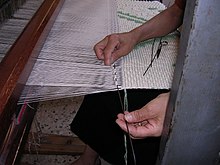Pibiones
The pibiones or grain weaving technique is most commonly found in the central and eastern areas of Sardinia, Italy.[1] This is a particular type of stitched relief, where the pattern is formed from the countless grains incorporated into the cloth during weaving.These are made by twisting the weft yarn around a needle which is arranged in a horizontal position on the loom; after the thread is beat into place, the needle is then pulled away, leaving behind a raised effect (grains).[2] Pibiones are used to decorate traditional Sardinian linen bedcovers, historically woven by young Sardinian girls to be included in their dowry (corredo).[1] The pibiones technique was used in antiquity only for the best hand-woven bedcovers sa faona and for household articles such as curtains, fabrics, cushions, and tablecloths.


knitting needleweaving techniqueSardiniareliefneedlecurtainsfabricscushionstableclothsWeavingBasketweaveCharvetCoverletDouble weaveEven-weaveGabardineLampasLeno weaveOxfordPile weavePiquéPlain weaveSwivelTextilesWarp and weftBarber-Colman knotterBeamerChilkat weavingFingerweavingFlying shuttleHeddleInkle weavingKasuriNavajo weavingSalish weavingShuttleSizingSizing machineTablet weavingTānikoTapestryTempleWattleWickerAir-jet loomDandy loomDobby loomHattersley loomHorrocks loomJacquard loomLancashire loomNorthrop loomPower loomRapier loomRoberts loomWarp-weighted loomAcesasAnni AlbersOtti BergerMicheline BeaucheminJohanna BrunssonAda DietzThomas Ferguson & Co LtdElisabeth ForsellDorothy LiebesEthel MairetMaria Elisabet ÖbergLilly ReichMargaretha ReichardtJohn RylandsBrigitta ScherzenfeldtClara ShermanGunta StölzlJudocus de VosMargaretha ZetterbergMore loomsKissing the shuttlePiece-rate listBancroft ShedQueen Street Mill